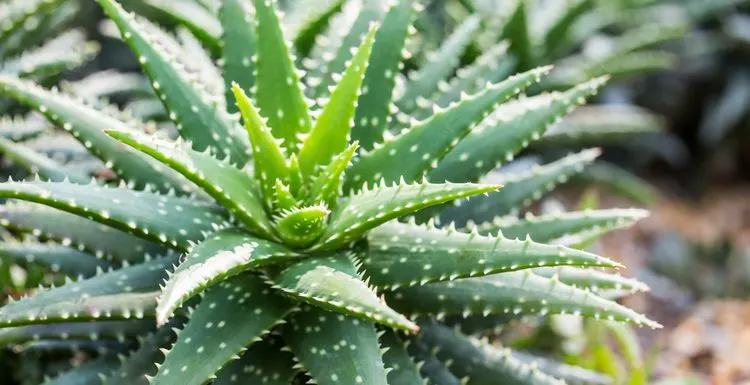Even though aloe vera is a resilient plant, like the related cactus, transplanting is a critical step to the plant’s health.
If you’re curious about why and how to transplant aloe vera, keep reading.
Transplanting Aloe Vera: The Basics
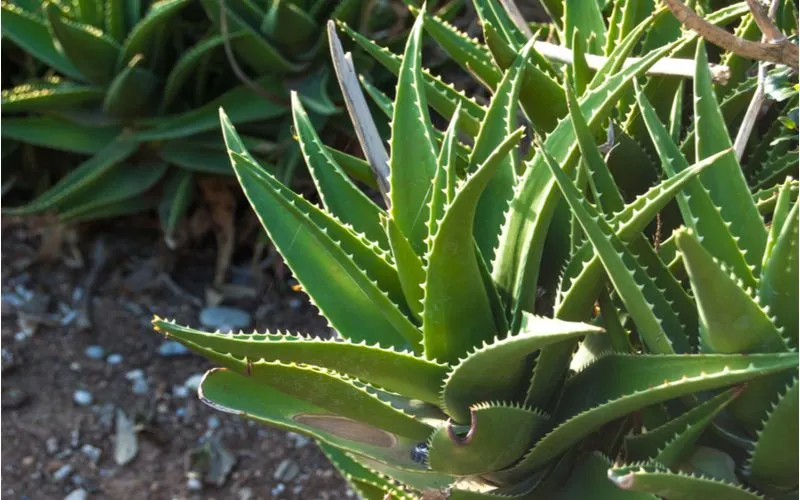
Viktorialvanets/Shutterstock
Transplanting refers to the process of moving a plant to new soil, whether that be in the ground or in a pot.
While you may think that plants can stay in one location forever, regularly transplanting or repotting aloe vera is necessary to ensure that the plant stays healthy.
Some of the fundamental facts to know about transplanting aloe vera include:
- Transplanting aloe vera is a way to move a plant to a bigger pot indoors or a different location outdoors.
- Mother aloe vera plants can develop offshoots, or pups, that split off from the main plant.
- Aloe is a hardy plant, but if you ignore separating the pups and transplanting the offshoots, the offshoots can slowly steal nutrients away from the mother plant, which will struggle and eventually die.
- Aloe vera requires a lot of sunlight to stay healthy, so choose your location wisely, particularly if you grow aloe indoors.
Now that we understand some of the basics, let’s get into the details about how and when you should transplant your aloe vera plants.
How to Transplant Aloe Vera
If you’ve owned any aloe vera plants for some time, then you probably know how hardy they are. Aloe vera is resilient and can survive harsh conditions. It’s particularly good at thriving in sunny and dry climates.
But aloe vera does have one necessary maintenance routine. When an aloe vera plant becomes too big for its pot, it needs to move into a larger environment with more space.
In transplanting aloe vera, you dig up the roots and move the entire plant into a different pot. Or, for a plant that’s outside, you can move it to a different location.
Most often, your main plant has too many offshoots. Offshoots will steal resources from the main plant, and dividing it becomes necessary.
What follows is more detail about when you should transplant your aloe vera and how to do it.
Why Transplanting Aloe Vera Is Important
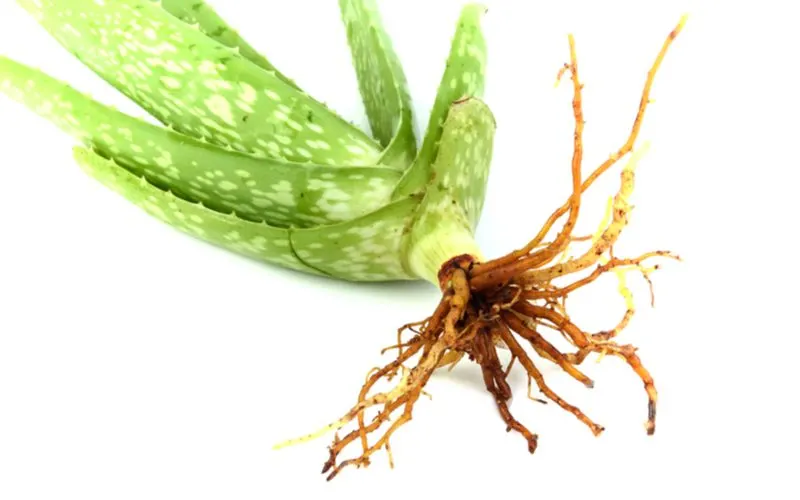
Single/Shutterstock
Transplanting aloe vera gives your plant a chance to continue thriving. While the plant can survive in a crowded pot for some time, it’ll eventually die if you don’t move it.
The plant will struggle both because it doesn’t have room to grow and because its offshoots will steal nutrients.
So transplanting and dividing the nutrients is crucial to keeping both the mother plant and the offshoots healthy.
And if your aloe plant is outside, there’s another reason that transplanting is essential: your plant might be in a bad location. Aloe needs a lot of sunlight, and if your original spot doesn’t get enough, your plant will struggle.
Another important reason for changing your aloe into a different pot is to change the soil. Healthy aloe requires clean soil that’s fresh and nutrient-rich.
Signs That Aloe Vera Needs Transplanting
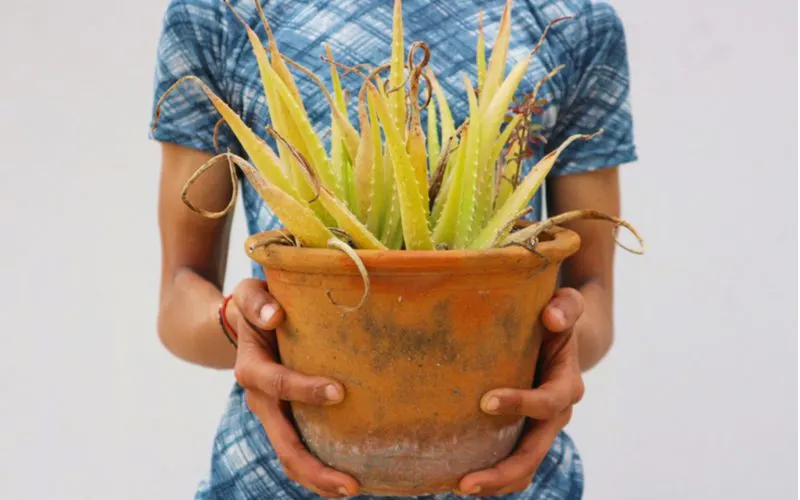
d_odin/Shutterstock
For the most part, aloe vera is a simple plant, and taking care of it is easy. It needs water and sunlight and should stay away from cold temperatures.
But you shouldn’t get lazy about transplanting. Moving your aloe vera plant keeps it healthy and will allow you to make more plants with the pups.
So keep an eye out for the following signs that tell you when it’s time to move your aloe:
- The plant has become too big for its pot. It can survive in a crowded space for some time, but don’t neglect it for too long.
- Your plant looks very top-heavy because it can no longer grow sideways.
- There are one or more pups (offshoots) growing along the side of your plant. We cover these pups or baby plants in more detail below.
- The soil in the pot looks unhealthy or degraded. Fresh and nutritious soil is vital for the health of an aloe vera plant.
- The soil doesn’t appear to be draining efficiently. When the soil isn’t draining, the roots of the plant will begin to rot.
Those are the main signs that the time has come to transplant your aloe vera. And for that, you can follow this step-by-step guide for moving your plants safely.
Offshoots or Pups
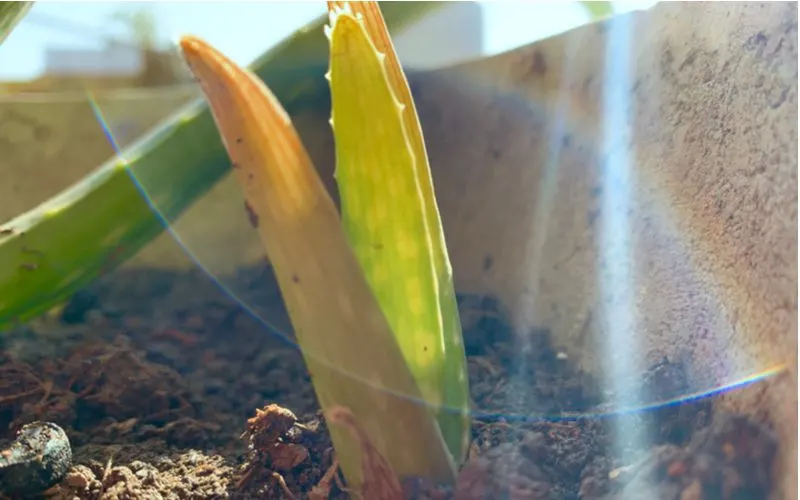
Vision Gaurav/Shutterstock
As mentioned, you’ll eventually notice small plants growing out of the side of an aloe plant as it matures. These offshoots are called pups, and they are like child plants to the main plant.
Like many mother-offspring relationships in nature, the pups share a root system with the main plant and take nutrients from it.
This process is natural, and it’s a great way to slowly increase your collection of aloe plants. But it’s important to eventually divide these pups from the main plant if you want both plants to stay healthy. And you also have to divide the pup at the right time.
If you divide them too early, then the pup will probably not survive. The roots won’t be mature enough and won’t take hold in its new soil.
But if you wait too long to divide them, then you risk damaging the mother plant. While the pup stealing nutrients from the mother is a natural process, it’ll eventually create an unhealthy situation for the mother.
In short, if you ignore the offshoots of aloe vera, your original plants will either struggle to thrive or even potentially die.
Transplanting Aloe Vera: A Step-by-Step Guide
Now that you have a solid grasp of the aloe vera plant and why you should be transplanting, let’s go over the process in a step-by-step fashion. Eventually, you’ll learn this routine by heart and won’t even need a guide.
To Transplant Aloe Vera:
- Find a clean pot (the new one) and make sure it’s big enough (about twice as big). It also needs a hole at the bottom for drainage. If it’s dirty, wash it out, then thoroughly dry it.
- Obtain potting soil for growing cactus or aloe vera plants. Break it up with your hands to eliminate lumps. You want a smooth and even texture.
- Fill the bottom of the new pot with a layer of rocks. The rocks will allow the water to drain and keep the soil from being too moist. Moist soil equals root rot.
- Fill the new pot with the soil until it’s about an inch from reaching the top.
- Gently lift the plant, supporting it by the roots, and remove the old dirt from around the roots.
- Dig a hole in the middle of the new pot big enough to fit the root system of the aloe vera, and place it inside. Fill in the gaps with soil and lightly water the new soil.
Location
Besides the nuance of transplanting aloe, it’s crucial to choose the correct location. Since aloe is a plant that grows in warm and dry climates, it naturally thrives in sunlight. So if you’re moving your aloe to a location outside, be sure that it gets enough sunlight.
Another consideration for outdoor plants is water. Aloe plants need water, but if they get too much, they will struggle. The soil can oversaturate the roots, leading to root rot. So besides sunlight, be sure to transplant the aloe to a well-drained area.
For indoor plants, be sure that the new pot is at least twice as big as the old pot that the aloe outgrew. Aloe will become too top-heavy if it doesn’t have enough horizontal space to grow.
And both sunlight and water also need to be considered for indoor potted plants. The sunlight factor is flexible because you can move the pot around your house to find the perfect spot.
Be sure the pot has a drainage hole in the bottom. And besides the hole, the rocks in the bottom help with maintaining continuous drainage.
Temperature
The last main consideration for transplanting aloe is temperature. Aloe plants naturally thrive in the south and southwest regions of the United States because of their warm and dry climates.
Moderate water and warm, sunny conditions are crucial for the health of the plant. Because of this fact, aloe cannot survive the winter in many locations, forcing many people to grow their plants indoors.
So as much as you might want to transplant your indoor plant to an outdoor area, you have to take the weather into account.
In cold temperatures, your aloe won’t thrive. If the temperature drops below freezing, it’ll likely die.
With potted aloe plants, though, you can at least move the plant in and out of the house depending on the weather. You can bring it outside to get the best sunlight and then bring it in at night whenever the weather gets cold.
Frequently Asked Questions
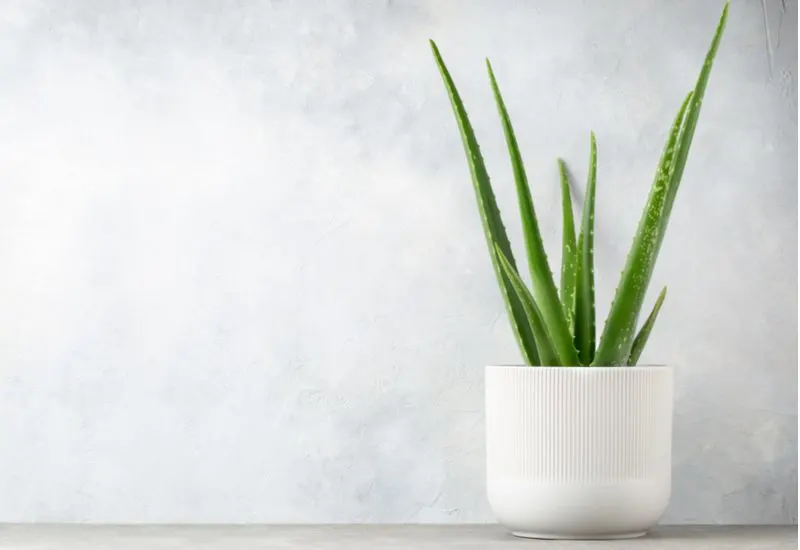
Eirene Fagus/Shutterstock
Now that you have the main idea of how transplanting aloe vera works, let’s go over some of the most frequently asked questions on this topic.
Combined with the information above, you’ll have the knowledge to confidently keep up with this maintenance.
How Do I Transplant an Aloe Vera Plant?
For outdoor plants, you should dig straight down in a circle around the roots of the plant. Once you’re underneath the mass of the plant, you can use the shovel to gently lift it out of the ground. The new pot should be at least twice as big.
At this point, you can also divide the plant if there are offshoots that are ready to survive on their own.
Can You Cut Aloe Vera and Replant it?
The short answer is yes. You can cut an aloe vera plant and replant it somewhere else, but there is some nuance to the process.
You should not, for example, just cut off one of the leaves and replant it. Instead, you should wait until your plant has mature offshoots and then cut those away from the mother plant.
When Should You Repot Aloe Vera?
You should be repotting your aloe vera regularly. However, if you aren’t quite sure when’s the perfect time to plot, watch the plant closely. Look for the following signs:
- Aloe has become too big for its pot.
- It’s looking top-heavy.
- The soil looks old and unhealthy.
- Offshoots or pups are growing out from the sides of the plants.
Again, aloe is a resilient plant so it will generally survive for a long time. However, ignoring these signs will become a problem in the long run. It’s best to be vigilant and repot regularly so you have a healthy, beautiful plant.
Can You Replant Aloe Without Roots?
It can be tricky to replant aloe without roots, but it’s possible. First, let the aloe leaf dry in a warm place to have the best chance of success—too much moisture can cause the new roots to rot.
So, What Should I Know About Transplanting Aloe?
Aloe vera is a beautiful and resilient plant to have in your garden, but regularly transplanting it’s an integral part of the maintenance process.
So keep an eye on your aloe vera plants, and be sure to return to this guide whenever you need to safely transplant your aloe vera plants.

